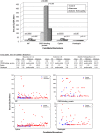Immunoproteomic analysis of potential serum biomarker candidates in human glaucoma
- PMID: 23150628
- PMCID: PMC3522442
- DOI: 10.1167/iovs.12-10076
Immunoproteomic analysis of potential serum biomarker candidates in human glaucoma
Abstract
Purpose: Evidence supporting the immune system involvement in glaucoma includes increased titers of serum antibodies to retina and optic nerve proteins, although their pathogenic importance remains unclear. This study using an antibody-based proteomics approach aimed to identify disease-related antigens as candidate biomarkers of glaucoma.
Methods: Serum samples were collected from 111 patients with primary open-angle glaucoma and an age-matched control group of 49 healthy subjects without glaucoma. For high-throughput characterization of antigens, serum IgG was eluted from five randomly selected glaucomatous samples and analyzed by linear ion trap mass spectrometry (LC-MS/MS). Serum titers of selected biomarker candidates were then measured by specific ELISAs in the whole sample pool (including an additional control group of diabetic retinopathy).
Results: LC-MS/MS analysis of IgG elutes revealed a complex panel of proteins, including those detectable only in glaucomatous samples. Interestingly, many of these antigens corresponded to upregulated retinal proteins previously identified in glaucomatous donors (or that exhibited increased methionine oxidation). Moreover, additional analysis detected a greater immunoreactivity of the patient sera to glaucomatous retinal proteins (or to oxidatively stressed cell culture proteins), thereby suggesting the importance of disease-related protein modifications in autoantibody production/reactivity. As a narrowing-down strategy for selection of initial biomarker candidates, we determined the serum proteins overlapping with the retinal proteins known to be up-regulated in glaucoma. Four of the selected 10 candidates (AIF, cyclic AMP-responsive element binding protein, ephrin type-A receptor, and huntingtin) exhibited higher ELISA titers in the glaucomatous sera.
Conclusions: A number of serum proteins identified by this immunoproteomic study of human glaucoma may represent diseased tissue-related antigens and serve as candidate biomarkers of glaucoma.
Conflict of interest statement
Disclosure:
Figures





References
-
- Maruyama I, Ohguro H, Ikeda Y. Retinal ganglion cells recognized by serum autoantibody against gamma-enolase found in glaucoma patients. Invest Ophthalmol Vis Sci. 2000;41:1657–1665 - PubMed
-
- Reichelt J, Joachim SC, Pfeiffer N, Grus FH. Analysis of autoantibodies against human retinal antigens in sera of patients with glaucoma and ocular hypertension. Curr Eye Res. 2008;33:253–261 - PubMed
-
- Dervan EW, Chen H, Ho SL, et al. Protein macroarray profiling of serum autoantibodies in pseudoexfoliation glaucoma. Invest Ophthalmol Vis Sci. 2010;51:2968–2975 - PubMed
Publication types
MeSH terms
Substances
Grants and funding
LinkOut - more resources
Full Text Sources
Other Literature Sources
Molecular Biology Databases
Research Materials

